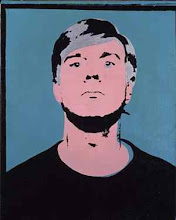 |
| Dan Graham, Two V’s Entrance-Way, 2016 |
Everything at Once: Lisson Gallery + The Vinyl Factory is at Store Studios, 180 The Strand, until 10 December 2017.
Marking the Lisson Gallery’s 50th birthday, this sprawling exhibition presents the work of 24 Lisson Gallery artists in the vast industrial spaces of the Store Studios. I enjoyed it hugely – even though much of the experience seemed to involve walking into black space and feeling your way to the audio-visual experience, which is not generally my idea of fun. (See the full list of participating artists here.)
My favourite installations included Dan Graham’s glass and steel ‘pavilion’, (Two V’s Entrance-Way, 2016), Haroon Mirza’s mesmerising sound and light installation, (A Chamber for Horwitz; Sonakinatography Transcriptions in Surround Sound, 2015), Shirazeh Houshiary’s pulsating chants and videos inside a black felt-lined space, (Breath, 2003) and Anish Kapoor's monumental ‘hat’, the dark interior of which swallows all light so that you stare into nothingness, (At the Edge of the World II, 1998). These works were all new to me but there were some old favourites here as well – Tony Cragg’s totemic stacks of industrial parts, (Minster, 1987), the longest Long I have ever seen, a mud wall-painting stretching the width of the building, (Peloponnese Line, 2017), and I was thrilled to see a couple of Julian Opie’s ‘empty cabinet’ works, (i and t, both 1988).
In an ironic way I even enjoyed my glimpse of part of one Marina Abramović’s early films: Freeing the Body, 1975 – watching this grainy black and white film of a woman, naked but for a mask, jiggling around to the beat of a bongo drum somehow seemed to encapsulate the essence of a certain sort of 1970s ‘third area’ art which seemed excruciating then, (and still does) but now made me laugh.
Marking the Lisson Gallery’s 50th birthday, this sprawling exhibition presents the work of 24 Lisson Gallery artists in the vast industrial spaces of the Store Studios. I enjoyed it hugely – even though much of the experience seemed to involve walking into black space and feeling your way to the audio-visual experience, which is not generally my idea of fun. (See the full list of participating artists here.)
My favourite installations included Dan Graham’s glass and steel ‘pavilion’, (Two V’s Entrance-Way, 2016), Haroon Mirza’s mesmerising sound and light installation, (A Chamber for Horwitz; Sonakinatography Transcriptions in Surround Sound, 2015), Shirazeh Houshiary’s pulsating chants and videos inside a black felt-lined space, (Breath, 2003) and Anish Kapoor's monumental ‘hat’, the dark interior of which swallows all light so that you stare into nothingness, (At the Edge of the World II, 1998). These works were all new to me but there were some old favourites here as well – Tony Cragg’s totemic stacks of industrial parts, (Minster, 1987), the longest Long I have ever seen, a mud wall-painting stretching the width of the building, (Peloponnese Line, 2017), and I was thrilled to see a couple of Julian Opie’s ‘empty cabinet’ works, (i and t, both 1988).
In an ironic way I even enjoyed my glimpse of part of one Marina Abramović’s early films: Freeing the Body, 1975 – watching this grainy black and white film of a woman, naked but for a mask, jiggling around to the beat of a bongo drum somehow seemed to encapsulate the essence of a certain sort of 1970s ‘third area’ art which seemed excruciating then, (and still does) but now made me laugh.
Read a reviews by Laura Cumming and Adrian Searle.
 |
| Haroon Mirza, A Chamber for Horwitz; Sonakinatography Transcriptions in Surround Sound, 2015 (detail) |
 |
| Anish Kapoor, At the Edge of the World II, 1998 |
 |
| Richard Long, Peloponnese Line, 2017 |
 |
| Julian Opie, i, 1988 |
 |
|
Marina Abramović,
Freeing the Body, 1975 (still from film)
|
 |
| Ryoji Ikeda - Test Pattern [N°12], 2017 |

